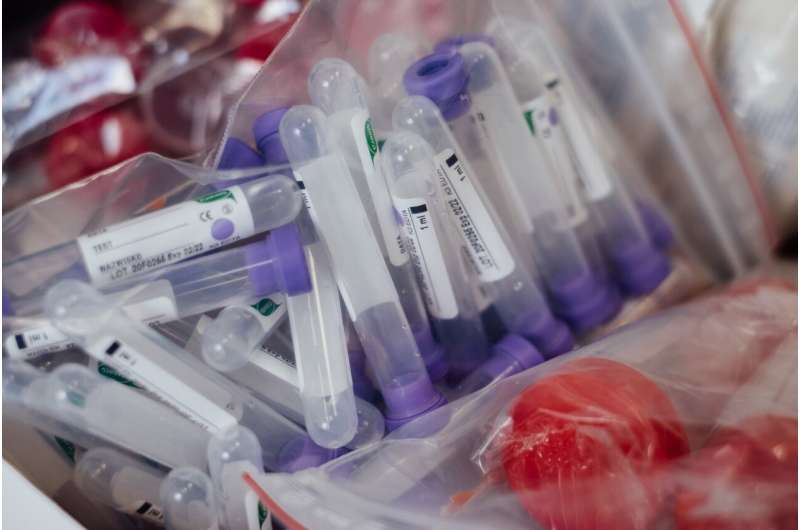Wuhan mass screening identifies hundreds of asymptomatic cases

A mass screening program of more than 10 million Wuhan residents identified 300 asymptomatic cases, but none were infectious—according to a study involving the University of East Anglia.
The mass testing project took place over two weeks at the end of May—after the city's stringent lockdown was lifted in April.
The study found no 'viable' virus in the asymptomatic cases and the close contacts of these positive asymptomatic cases did not test positive.
But the research team warn that their findings do not show that the virus can't be passed on by asymptomatic carriers.
Rather, strict non-pharmaceutical interventions such as mask-wearing, hand washing, social distancing and lockdown have helped reduce the virulence of COVID-19.
The study, published in Nature Communications, was led by researchers at the Huazhong University of Science and Technology (HUST) in Wuhan, China—in collaboration with researchers at UEA's Norwich Medical School.
Prof Fujian Song, from UEA's Norwich Medical School, said: "Wuhan was the most seriously affected city in China by the COVID-19 pandemic.
"After stringent non-pharmaceutical interventions and lockdown measures from 23 January 2020, the city's lockdown was lifted on 8 April 2020.
"To assess the post-lockdown risk of COVID-19 in the city, a mass screening project of nearly 10 million Wuhan residents was carried out between May 14 and June 1.
"This screening program identified 300 asymptomatic cases. But the virus cultures indicated no viable virus in the identified asymptomatic cases. This means that these people were not likely to infect anyone else."
The asymptomatic cases were found among people aged between 10 and 89, however the asymptomatic positive rate was the lowest in children and teens aged under 17 and highest among people aged over 60.
Further swab testing of 1174 close contacts of these 300 asymptomatic positive cases were all negative.
Prof Song said: "What this tells us is that the infection prevalence of COVID-19 was very low five to eight weeks after the end of lockdown in Wuhan.
"This work confirms that transmission of COVID-19 can be successfully controlled by well implemented non-pharmaceutical interventions, including face covering, hand hygiene, safe social distancing, contract tracing, and lockdown restrictions. Actually, mask wearing remains common in public places now in Wuhan."
However, the research team say that it is important to emphasize that the results of this study should be correctly interpreted.
Prof Song said: "The asymptomatic cases identified in the screening program in Wuhan were truly asymptomatic, as none of them showed clinical symptoms before or during their follow-up isolation.
"But there is plenty of evidence elsewhere showing that people infected with COVID-19 may be temporarily asymptomatic and infectious before going on to develop symptoms.
"It's also very important to say that these asymptomatic cases were identified shortly after the relaxation of a very stringent lockdown in Wuhan that lasted more than 70 days. By then, the epidemic in Wuhan had been effectively brought under control.
"The virulence of COVID-19 may be weakening over time. And it is likely that the viral load of Wuhan's asymptomatic cases may be low, compared with cases in locations with a high level of virus transmission.
"Antibody testing showed that almost two thirds of the asymptomatic cases had previously had COVID-19.
"Because the risk of residents being infected in the community was greatly reduced, when susceptible residents are exposed to a low dose of virus, they may tend to be asymptomatic as a result of their own immunity.
"So, it would be problematic to apply the results of our research to countries where COVID-19 outbreaks have not been successfully brought under control.
"Actually, the existence of asymptomatic cases remains a concern even in Wuhan. It is too early to be complacent, because of the existence of asymptomatic positive cases and high level of susceptibility in residents in Wuhan.
"Public health measures for the prevention and control of COVID-19 epidemic, including wearing masks, keeping safe social distancing in Wuhan should be sustained. And vulnerable populations with weakened immunity or co-morbidities, or both, should continue to be appropriately shielded."
"Post-lockdown SARS-CoV-2 nucleic acid screening in nearly ten million residents of Wuhan, China" is published in the journal Nature Communications.
More information: Shiyi Cao et al. Post-lockdown SARS-CoV-2 nucleic acid screening in nearly ten million residents of Wuhan, China, Nature Communications (2020). DOI: 10.1038/s41467-020-19802-w



















